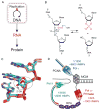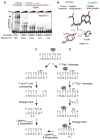Ribonucleotides in DNA: origins, repair and consequences
- PMID: 24794402
- PMCID: PMC4065383
- DOI: 10.1016/j.dnarep.2014.03.029
Ribonucleotides in DNA: origins, repair and consequences
Abstract
While primordial life is thought to have been RNA-based (Cech, Cold Spring Harbor Perspect. Biol. 4 (2012) a006742), all living organisms store genetic information in DNA, which is chemically more stable. Distinctions between the RNA and DNA worlds and our views of "DNA" synthesis continue to evolve as new details emerge on the incorporation, repair and biological effects of ribonucleotides in DNA genomes of organisms from bacteria through humans.
Keywords: DNA polymerase; DNA repair; DNA replication; Genome instability; Ribonucleotides.
Published by Elsevier B.V.
Conflict of interest statement
The authors have no conflict of interest to declare.
Figures




References
-
- Crick F. Central dogma of molecular biology. Nature. 1970;227:561–563. - PubMed
-
- Li Y, Breaker RR. Kinetics of RNA degradation by specific base catalysis of transesterification involving the 2′-hydroxyl group. J Am Chem Soc. 1999;121:5326–5372.
-
- Egli M, Usman N, Rich A. Conformational influence of the ribose 2′-hydroxyl group: crystal structures of DNA–RNA chimeric duplexes. Biochemistry. 1993;32:3221–3237. - PubMed
-
- Jaishree TN, van der Marel GA, van Boom JH, Wang AH. Structural influence of RNA incorporation in DNA: quantitative nuclear magnetic resonance refinement of d(CG)r(CG)d(CG) and d(CG)r(C)d(TAGCG) Biochemistry. 1993;32:4903–4911. - PubMed
Publication types
MeSH terms
Substances
Grants and funding
LinkOut - more resources
Full Text Sources
Other Literature Sources
Molecular Biology Databases

